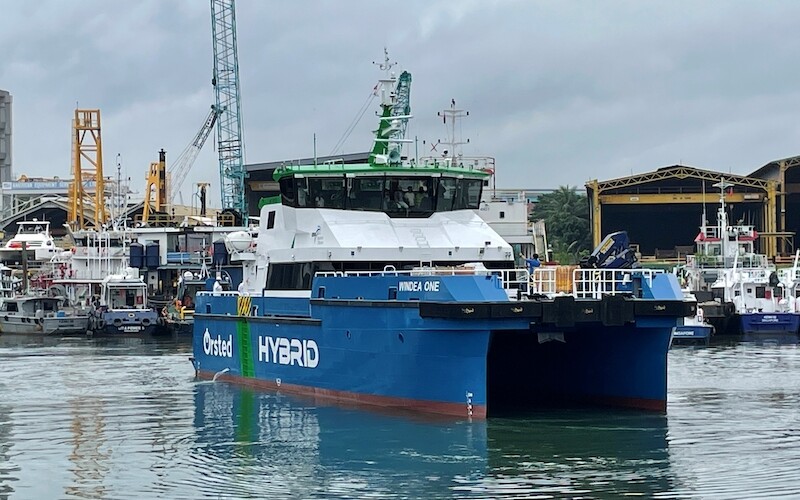The first 104.3'x32.8x14.2 parallel hybrid aluminum crew transfer vessel (CTV) designed by Incat Crowther for Emden-based EMS Maritime Offshore (EMO) has been successfully delivered, with the vessel already servicing Germany’s offshore wind industry.
Windea One, which has a 4.9' draft, is the world's first CTV to utilize Volvo Penta’s new parallel hybrid system together with IPS 30 propulsion units and can be operated in an all-electric mode for up to six hours. There are a total of four D113s, each producing 690 hp at 2,250 rpm. The propulsion package gives the new CTV a running speed of 25 knots.
Built by Singapore's Penguin Shipyard International, under the designation WindFlex-32, Windea One is based on Incat Crowther’s 32-meter CTV model. The hybrid vessel is IMO Tier III compliant and represents a step change in the sustainability of the offshore wind support industry, Incat officials said in a statement announcing the delivery.
Following an inauguration ceremony in Germany earlier this month, Windea One will now be deployed by Orsted to service its wind farms in the North Sea.
Capable of speeds of up to 28 knots, the new CTV will be serviced by up to six crew and will transport up to 24 service personnel between the European mainland and the North Sea.
The vessel's upper deck has two single office cabins, a bathroom, a crew mess, and galley along with an office/meeting room.
The main deck features a client cabin and first aid room, along with two separate spacious accommodation areas for technicians, a technician change area, and two bathrooms. The hull features four additional crew cabins.
Windea One has also been fitted with a hydraulic knuckle-boom crane, capable of carrying loads of up to 50 tons.
The vessel incorporates Incat Crowther’s Resilient Bow Technology thus minimizing boat landing impact forces.
Ed Dudson, managing director of Incat Crowther Europe said the Windea One project saw Incat Crowther incorporate leading-edge technology into the design.
“The inclusion of Volvo’s new parallel hybrid propulsion system in this vessel places EMO at the cutting edge of the industry. Not only can the vessel be operated in a fully electric mode, but there are also options to switch to biofuel, helping to further reduce emissions and the vessel's impact on the environment,” said Dudson.
Tankage includes 9,378 gals. of fuel oil and 925 gals. fresh water.
“It’s been fantastic working closely with EMO and our strategic partner Penguin to deliver Windea One. With the vessel now in the water, we are confident it will be the first of many to incorporate hybrid propulsion systems as operators look to maximize efficiency and reduce emissions.”
Ship’s service power comes from a pair of Kohler gensets, sparking 44 kW of electrical power each.




